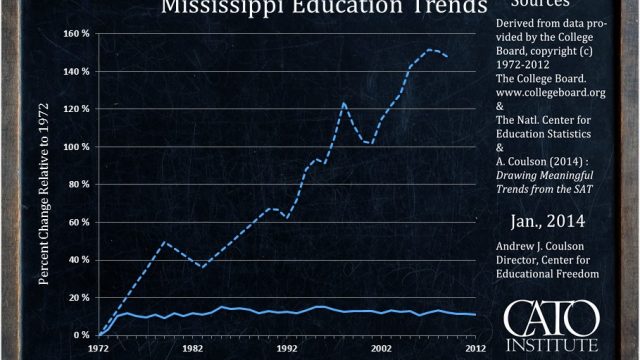Mississippi education spending goes up while student performance flatlines

NOT A PASSING GRADE: Despite increased K-12 education outlays, student performance has remained about the same, according to a 40-year study by the Cato Institute.
By Steve Wilson | Mississippi Watchdog
Despite massive increases in public education funding, student performance has either remained constant or declined nationwide.
Mississippi is no different.
The study by the Cato Institute’s Andrew J. Coulson, director of Cato’s Center for Educational Freedom, analyzed data collected since 1972 for per-pupil spending and student performance using state SAT score averages adjusted for participation rates and student demographics.
Mississippi education spending has risen since 1972, but the student performance, as measured by the SAT averages, has remained the same or gone down.
The Mississippi Legislature increased K-12 education funding by 3.8 percent for fiscal year 2015, going from $2.34 billion in 2014 to $2.43 billion. That figure represents 40.5 percent of the state’s $6 billion budget.
“The fact that inflation-adjusted per pupil spending has more than doubled over the past 40 years while academic achievement has stagnated or declined is a huge disappointment,” Coulson said. “But rather than spend time allocating blame it seems more productive to ask: how can we turn things around? What kinds of education systems make the most effective use of every dollar they spend?
“If we really care about children’s education, it’s not enough to just spend more on it year after year. We have to make sure that we make the best possible use of our limited resources or we shortchange students.”
Coulson said school districts awash in ever-increasing funding have been on a hiring spree nationally. Public schools have hired twice as many people to educate only 9 percent more students. Employment has grown 11 times faster than enrollment.
“If all those new employees had improved student achievement, that would be great,” Coulson said. “But they haven’t. Sadly, our school systems have squandered the talents of so many of their employees that adding 3 million people (nationally) to the rolls has done nothing for students’ verbal or mathematical achievement.”
Despite the study, there’s a strong possibility that spending will continue to increase. Mississippi K-12 funding will gobble up an even bigger chunk of the state’s budget if a proposed ballot initiative on education funding is approved by the state’s voters.
The Mississippi Adequate Education Program, a state law, says $2.43 billion isn’t enough. The law was passed in 1997 by a Democrat-majority Legislature over the veto of Republican Gov. Kirk Fordice. Only twice, in 2003 and 2007, has the Legislature met the full requirements of the MAEP formula because lawmakers are not constitutionally obligated to completely satisfy the funding requirements of the MAEP formula.
MAEP has a complicated formula designed to ensure every school district gets adequate funding from the state. It takes into account factors such as average daily attendance, number of teachers per 1,000 students and the percentage of students qualifying for free lunches. Using successful school districts as a baseline, the numbers are recalculated every four years and are adjusted for inflation with numbers provided by the state economist.
Even though education funding increased, it would’ve taken more than $250 million in addition to satisfy the MAEP formula this year.
A nonprofit organization Better Schools = Better Jobs is trying to collect 107,000 signatures before Oct. 1 to place an initiative on the state ballot in 2015 that would make fully funding MAEP a constitutional requirement.
Contact Steve Wilson at swilson@watchdog.org
Get regular updates on Mississippi through our Facebook or Twitter accounts







